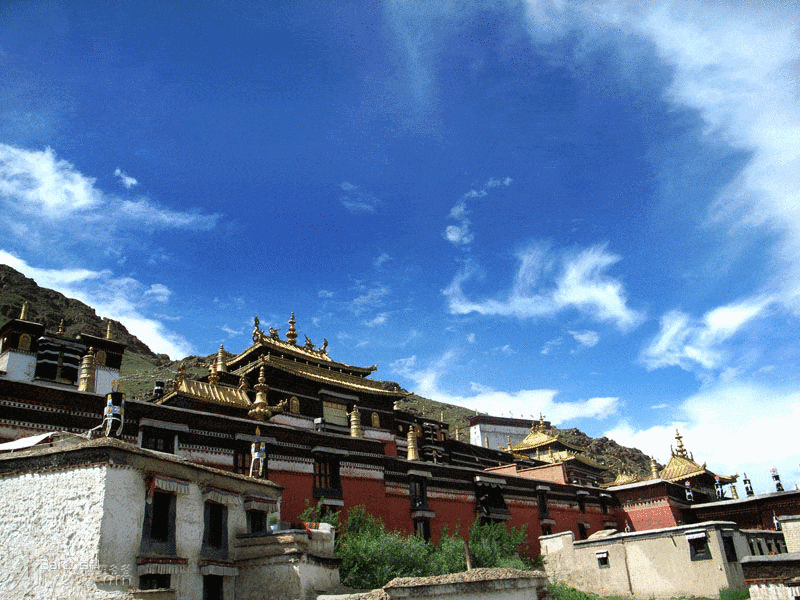Chinese Name: 夏鲁寺 Pronunciation: xià lǔ sì
Building Time: 1087
Opening Hours: 9:00-17:00
Suggested Visiting Hours: 2 Hours
Building Function: To spread doctrines of Tibetan Buddhism
Address: Shalu Village, Jia Cuoxiong Township, Shigatse City, Tibet
Best Visiting Season: Spring and Autumn (March to May, September to November)
Admission Ticket Fare: 40 yuan (The following attractions, such as Shalu Hall and Four treasures are free of charge.)
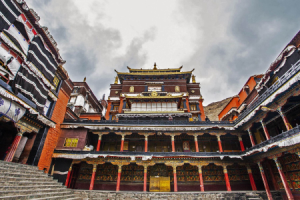
Located in a Congdui Valley 26 kilometers southeast of Shigatse City, Shalu Monastery was founded in 1087. It is a famous temple of the Shalu Sect in Tibet.
Congdui means commercial markets. It was once one of the top ten commercial markets in Tibet during the Tubo Period, and it was the most famous one among 130,000 households in Tibet during the Yuan Dynasty. Later, it gradually fell into recession and we can still see the walls of the old Chaluwanhu Palace.
Shalu Monastery is also called Shalu Kloster. The name of “Shalu” means a new bud or young leaf in Tibetan Language. The funny name hides an amusing anecdote. A monk named Gideon Ciro Jonay wanted to build a monastery to spread the teachings of Tibetan Buddhism. He asked the teacher for the construction site. His teacher suggested that he had better go to the shooting place and shoot an arrow. The arrow landed on a new bud, hence the name Shalu came up.
Shalu Monastery is a perfect combination of Han and Tibet architectural styles. The hall is in Tibetan style and its walls are all made of irregular stones. The top of the hall is in the Han style, covered with green glazed tiles, reflecting the architectural style of the Yuan Dynasty. One of the distinguishing features of this ancient temple from other major temples of the Yellow Sect is its exceptional simplicity and purity. The murals at Shalu Monastery are of great value because of their long history.
Shalu Monastery is a key cultural relic site under national protection. It is an ancient temple built in the early stage of the Later Hongshi Period of Tibetan Buddhism and the main temple of the Shalu Sect of Lamaism (Buton Sect).

In 998, Tibetan Buddhism entered the later period. After the Buddha was banned at Rhonda, ten Buddhists who defended Tibetan Buddhism heard that the great Lama Qin Gomba Huosai (about 891 ~ 975), who was an eminent monk fleeing from Tibet to Qinghai Province, went to worship him as their teacher.
In 1087, one of the ten Buddhists, Loten Dorje Wangxiu, returned to Tibet and built a temple in Jiacuo, southeast of Shigatse City. The temple is named Jian Kong. Loten Dorje Wangxiu took in an apprentice named Gideon Ciro Jonay. Gideon Ciro Jonay went to India to study and became a knowledgeable Buddhist and then built the Shalu Monastery.
In1320, Burton Rinchingchu who was the founder of the Shalu Sect (Buton School) rebuilt the Shalu Monastery. He spread the four secret teachings, edited and compiled the catalog of the Buddhist scriptures.
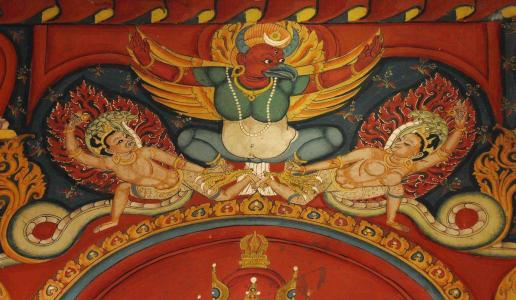
In 1329, the Shalu Monastery was destroyed in the Shigatse earthquake. When the Yuan Emperor learned that the temple was destroyed in the earthquake, he ordered Yoshiza to return to Tibet and restore it, and gave him a large sum of money to restore it.
In 1333, Chinese and Tibetan craftsmen worked together to build this temple with a special style of a mixed structure of Han and Tibet. With the great support of the Yuan Emperor, Burton expanded and maintained the original temple.
Between 1981 and 1989, the government allocated a large sum of money for repairing and restoring it to its original look and characteristics. There are more than sixty monks now.
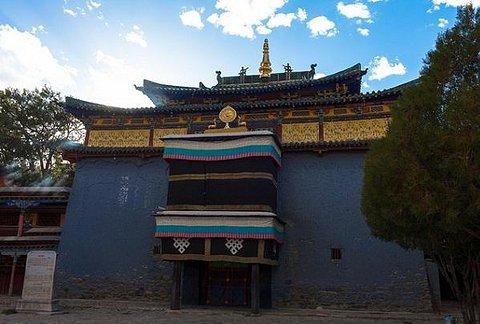
Shalu Monastery originally consisted of the Shalu Hall and four Zachang, which are scattered around the hall and are now residential buildings. Covering an area of more than 1500 square meters, Shalu Hall has 49 houses.
Shalu Hall, also called Shalu Lacan, is the main building in the Monastery. The Shalu Hall sits west and faces east with two floors. The main hall on the ground floor is the assembly hall, with an area of about 1500 square meters. The statues of Sakyamuni and his eight disciples are worshiped in the assembly hall. There is a scripture hall on each side of the assembly hall which exhibits two important classics of Tibetan Buddhism - Tanjur and Kanjur.
The second floor is a Chinese-style courtyard building with main hall, side hall and front hall. The main hall worship statues of Sakyamuni and Burton Rinchingchu. The front hall enshrines the Buddha of Mercy and the Sixteen Arhats.
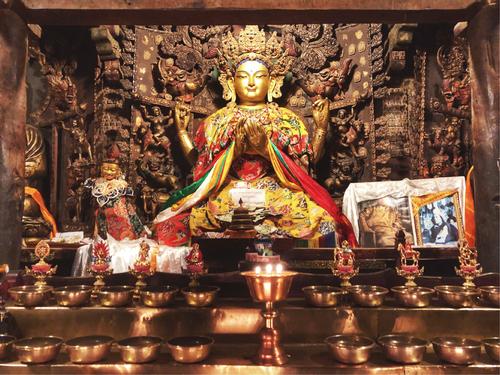
Shalu Temple houses a large collection of historical relics such as murals, Buddha statues, scriptures, thangkas, and Dharma artifacts, of which it is known for its four treasures.
The first treasure is the Scripture Board that is composed of 108 blocks of sandalwood and each block is engraved with a sutra. Worshipers believe that they will wipe out evil and bring a good fortune if they get a piece of the sutra board.
The second treasure is the Holy Water Altar. It is a large bronze altar, 80 centimeters in diameter, located in the southeast corner of the Main Assembly Hall. The water in the Holy Water Altar, renewed every 12 years, can guarantee a lifetime of good luck and wash 10 kinds of dirt.
The third is the Natural Six-Character Mantra Stone. It is said that the stone is inscribed with six characters and its edge is engraved with four delicate pagodas.
The fourth treasure is the Stone Washbasin. It is said that the water inside the Stone Washbasin would not flow over even on a rainy day. The living Buddha Gideon Ciro Jonay who built the Shalu Monastery always washed his face in this Stone Washbasin.
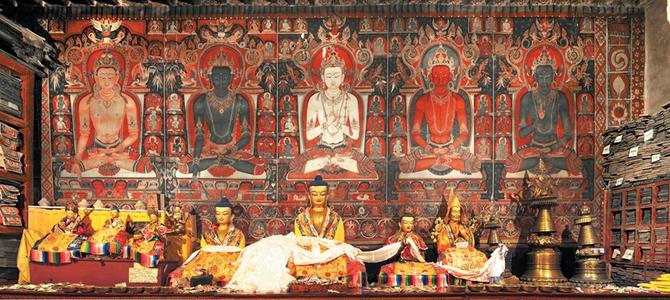
“Shalu style” refers to the painting styles formed in monasteries such as Sakya Monastery and Shalu Monastery. This style forms under the influence of Nepalese art around the 14th century. The murals in the Shalu Monastery have made outstanding achievements and are well-preserved with clear characteristics. Then people use the “Shalu Style” to refer to this painting style. The Nepalese style is seductive in shape but lacks pure and brilliant color. Filtered by the simple and sincere Tibetan national character, it makes the quiet and elegant temperament into a magnificent visual effect.
The murals that represent Shalu style are mainly works that were restored after the year of 1333. Surrounding Hall is a closed passage corridor, and the outer wall of the corridor is painted with stories of Buddha’s biography and life origin. On the first floor, there are murals on the theme of King Kong Realm inside the hall. On the second floor, the winding corridor of the front hall is painted with a story. This story tells about the Karma Story Painting of Sumagadhi. The highest artistic level mural works of Shalu Monastery are mainly in the main hall corridor, the first-floor auxiliary hall, and the second-floor front hall corridor.
The overall artistic level of the murals in Shalu Monastery is superb and neat, producing the most outstanding works in the history of Tibetan painting, with harmonious and unified style, clear artistic style, and its system. The elements of its style have three main aspects. For the first aspect, the Baltic Tibetan painting tradition, which rose from the 11th to the 13th century, has laid a good foundation for Shalu art. At the same time, the builders of the Shalu Monastery have a good aesthetic viewpoint by learning the Baltic Tibetan painting tradition. They are inseparable from the wisdom of Shalu art. For the second aspect, Nepalese art provides a direct stylistic paradigm for the formation of the Shalu-style system, which constitutes the core part of the painting style of Shalu Monastery. For the third aspect, the second extension of Shalu Monastery involves a large number of Han craftsmen. Thus, the architecture is the product of the perfect combination of Han and Tibetan architectural styles, which is not only reflected in the architecture but also in the murals. The Central Plains culture is organically integrated into the Tibetan painting.
The appearance of murals in the Shalu Monastery is an important event in the history of Tibetan painting. It declares the end of the influence of the early Polo-style art in the post period. The painting style of Shalu Monastery replaced the dominant position of Polo style in the painting field and influenced the whole 14th century with a new artistic charm. It laid a foundation for the emergence of Baiju temple art in Gyangze. Later, it affected the Garze art in the western region of Ariladak, leading us to find the existence of Shalu art in the Garze art in the western region of Ariladak. At the same time, the illustrations of Tibetan Buddhist scriptures of the Yuan Dynasty(1271-1368) in the Central Plains also left traces of Shalu style.
The murals of the same style in the same period of the Shalu Monastery can be found in the Gyangze Zong’s Juenang Temple. These are examples of the Shalu style of art that was widely popular throughout later Tibet in the 14th century.
1. The shape of the face has changed from a little longer to a little shorter. The head is wide up and narrow down, big up and small down. The facial features are more concentrated, the position of the eyes has dropped a lot, and the brow and forehead above the eyes are larger, such as the proportion of children’s faces. They have slender limbs and small hands and feet. The characters wear single-layer five-leaf crowns, and the axial earrings have been replaced by big earrings.
2. There are ancient forms and systems in the main composition layout such as Dancing Dragon Man, Dragon Woman, Capricorn fish etc. The lotus throne is straight. Colorful lotus petals are mostly single-layer up or down. In the middle of the pedestal, there is decorative cloth with round flowers or rolled grass. In the middle of the pedestal, there are also images of exotic animals, rare birds and Hercules etc.
3. Line drawing is the “iron line drawing” without change. There are “high light spots”, that expressing third dimension and gloss or decorative bright lines suggesting highlights on the face, the belt, the ornaments, and the leaves and stems of plants. In other words, line drawing pursues for steadiness. The decorations and stems of plants look three-dimensional through line drawing.
4. The painting unit is the scroll acanthus design, the rhythm and organization of which can be found in all parts and details. The penetration of the Central Plains art tradition makes the design of garment belt have the trend of being large and fluttering.
Take the bus from the Passenger Terminal at Shanghai Middle Road of Shigatse City, and get off Shalu Monastery Station. (It takes about 5 yuan.)
